Welcome to the Imperial Archives! The main source of information in the Galactic Empire. Be sure to check out the Editing Protocol before making new pages or editing articles. If you need help feel free to contact the Archives manager at archives@swc-empire.com !
Talravin System
| Talravin System | |

| |
| Sector | Kuat Sector |
| Galactic coordinates | 57,43 |
| Planets | 4 |
| Moon | None |
| Asteroid Fields | None |
| Space Stations | 16 |
| Population | Approx. 263 million |
| Controlled By | Galactic Empire |
Return to Kuat Sector

|
RESTRICTED FILES......
INITIATING INDENTIFICATION SCAN.........

|

|
SCAN COMPLETE......
FINALIZING REQUEST.........

|
SYSTEM ACCESS......
ACCESSING RESTRICTED FILES.........
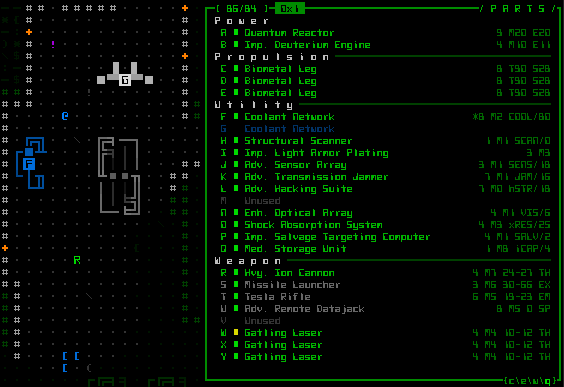
|

|
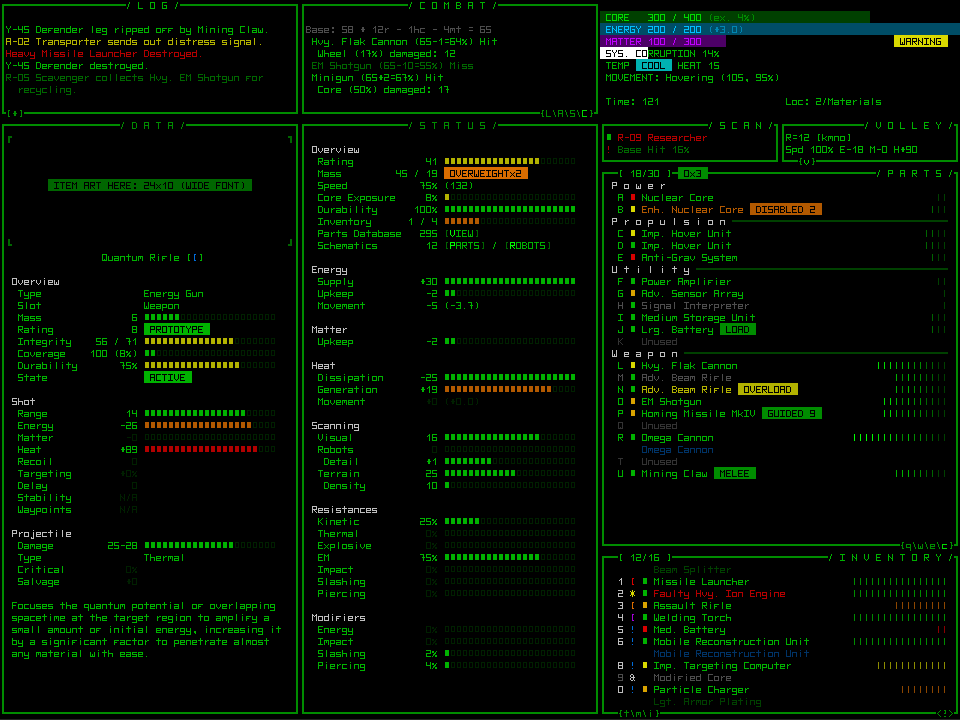
|
Contents
[hide]Imperial Port Authority Notice
Intergalactic travel through the Talravin system is Restricted to Imperial Personnel, unauthorized access is a violation of Imperial Law.
Port Authority status of planet Talravin I: Closed, only authorized personnel.
Port Authority status of planet Talravin (II): Restricted, shield access permission required.
Port Authority status of planet Talravin III: Restricted, shield access permission required.
Port Authority status of planet Talravin IV: Restricted, shield access permission required.
Talravin System
The Talravin System is one of the seven systems in the Kuat Sector. It currently houses a total of four planets, most of which are fairly inhabitable. The Talravin system lies along the Southern border of the Kuat Sector. Much like its closest neighbors the Vuma System and the Raxxa System, it was ignored by the Galactic Empire for many years due to the systems inhospitable planets.
Today there is a lot of mystery surrounding the Talravin System. It's current restricted access combined with its patchy history has kept it a hot topic for Courscanti conspiracy theorists. Some believe the system to hold dark secrets, buried by the Empire over the years. Reports of experiments gone wrong and violations against sentient beings have been on the lips of theorists for decades. Others believe that ancient ruins buried deep under the snow laden surface of Talravin (I) holds keys to powers older than that of The Force.
A Search for Identity
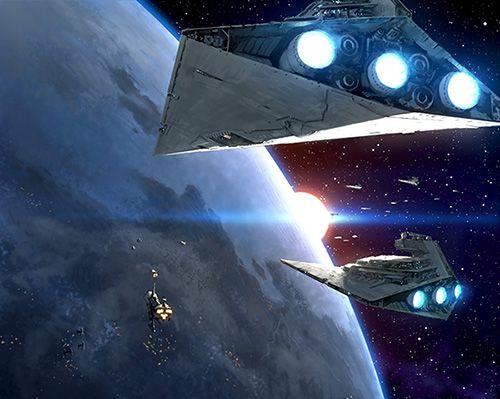
|
| Tensions high between Galactic Empire & Imperial Core |
Talravin was first recognized just before the second reign of Emperor Vodo Bonias. Vodo was a Sith Warlord who formed the Dark Empire. The Dark Empire came about during the The Great Break, when the Imperial government had been torn apart by two warring factions, the Imperial Core and the Galactic Empire. Eventually Vodo, upon his return convinced the Emperor Charon to merge the two sides in an attempt at peace. During this combine of the two sides, those initially loyal to the Imperial Core and the former Dark Empire, were opposed to returning to the Empire's capital city of Coruscant. Many Sith formerly under the rule of the Dark Empire went searching nearby systems for any undiscovered assets that would give them advantages over their enemies. Small scavenger parties were formed to prod Talravin and other nearby systems for anything that may aid their allies and themselves.
This search produced minimal results other than a handful of fossils scattered across Talravin & Talravin (I). The Galactic Empire was soon wrapped in civil war again, with the rise of Emperor Greyson Uebles and eventually the installation of Vodo Bonias as emperor for his second reign. When Greyson Uebles stepped down to make way for Emperor Bonias, he disappeared. Reports and sightings manifested throughout the galaxy for some time after but eventually ceased and were forgotten. Uebles was rumored to have made a stop through the Talravin System, due to the lore surrounding the planet Talravin itself.
A Search for Meaning

|
| Planetary scan |
After the temporary stabilization of the Galactic Empire by Emperor Bonias, Talravin became a target for developing new scientific research studies on sentient understanding and cultural advancement. Many research stations have been built in the Kuat Sector over the years due to the ever growing Kuat Drive Yards, placing importance on weapon and ship technology development. The Talravin System would be different. Emperor Bonias saw the constant struggle among his Imperial citizens to co-exist with species of varying cultural and biological differences. The Empire itself has always prescribed to a classification of all species when it comes their their involvement in the structural importance within the galaxy.
In the fifth year of the galactic timeline, Bonias ordered stations to be constructed in the Talravin system. Speculations about their purpose was widely debated among citizens throughout the Empire. The stations themselves were erected fairly quickly. Many within the Imperial command were surprised at how soon the stations were completed and filled with scientists and engineers. Five research stations were eventually built within the system. The total project took less than a galactic year to complete. To ensure the stations had way access, a shipyard was constructed in the middle of them, as a hub for Imperial scientists to gather and discuss their findings in a communal setting.
In the early years of their existence, they were fairly simple structures, outfitted with minimal devices used to carry out minor experiments on microorganisms and local plant life. The stations were to work as teams in a effort to better understand how certain subspecies spread throughout the galaxy. Scientists led survey missions throughout Imperial territories and beyond, tasked to gather small samples of varying planet vegetation, minerals and even the occasional organism. Other governments cooperated with the Empire's efforts in the early years, applauding their strive to better understand the galaxy and its inhabitants. This soon attracted private investors who contracted Imperial scientists to follow leads of their own genealogical makeup in hopes of uncovering their ancestral connections and beginnings.
With an influx of new funding and the Imperial High Command seeing potential for growth, the facilities soon started to see an upgrade. New additions to the old research stations were added and some were even replaced with newer and larger more functioning versions. Credits were pumped into the research projects like never before. Even the scientists were shocked at how much funding was coming through and hired bigger financial teams to manage its use. This new growth prompted scientists to reach farther than ever before. In the early years restrictions were placed on where and what they could study, but as interest and new findings rose, restrictions slowly started to fade. This was seen by many as a triumph for the world of science and cultural advancement, but those opposed would mark it as the beginning to a tragic end.
Unrestricted Access
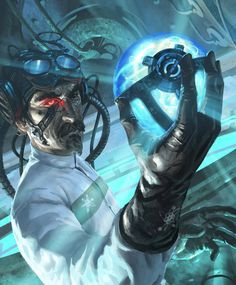
|
| Thomas Khan developing biological weapons |
Scientists were always careful in their studies. They adhered to strict regulations and a code of laws, emphasis always being made in regards to safety and protocol. Once the influx of funds began to pour in and more and more scientists were brought on board, these regulations and code of ethics began to wear thin. Scientists wanted bigger and better and many became arrogant and careless. The best example of this was a scientist by the name of Thomas Khan. Thomas had been working on Research Station Alpha since the projects inception. He was personally chosen by Imperial High Command due to his extensive background in alien anatomy and microbiology. Thomas was a teacher at one of the leading universities on Coruscant before being called upon to lead the research team aboard Alpha.
Thomas, in the beginning was a true leader; resourceful, temperate, and creative. He made several advancements in his studies of microorganisms in regards to their behavioral tendencies in situational scenarios. He was adored by his colleagues and honored again and again by Imperial Command for his achievements and contributions to the Galactic Empire. Command began entrusting Thomas with other experiments, mostly biological weapons, to be used in the case of war between the Empire and the Krath Dynasty. Tensions were always high and Imperial Intelligence urged the emperor to ensure the Empire had every advantage possible in the case war did break out. Thomas continued to work diligently and he continued to be showered with honors and awards for his contributions.
This constant appreciation and praise is what eventually led to a shift in Thomas's behavior. Before long he became arrogant and prideful. He found that he could manipulate his team members into believing anything and that's all he needed to begin his own experiments. Thomas's specialty was living organisms. When he found new ways to weaponize the biological power he was specialized in, he also discovered a deeper potential for biological beings when it came to weaponization.
An Ego Unchecked
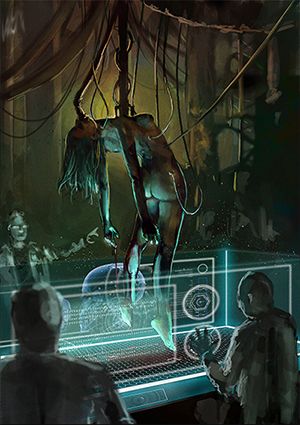
|
| Human experiments became commonplace |
A live Twi'lek subject? The idea of using a living, breathing, and intelligent life form in an experiment made his team wary in the beginning stages. Thomas sensed that his team was unsure of his motives and put them at rest by having close contacts within High Command, sign off on the experiments. What the team didn't know, was that the "official documents" were in regards to a supposed medical condition, on which to treat subjects for diseases contracted in other sectors. Thomas simply made some easy edits to the document, convincing his team he had full permission from Imperial Command.
With his team onboard, the experiments began. Simple modifications were made at first. Non-evasive implants, minor limb augmentation, but before long, things would spiral out of control. Specimens were placed into tanks and monitored after biological shifts in their organs and cellular structure were made. The subjects began to die, but Thomas was insistent that this was part of the process. Thomas, eager and still deeply funded, was able to enlist galactic mercenaries to capture and bring new subjects into his lab for experimentation. He forged new documents that made it seem as if the Empire were supplying the subjects. Other parts of the lab, originally used to study microorganisms and plant life, were torn out to make way for more species from all over the galaxy.
A few behavioral adjustments and skin pigment alterations weren't enough for Thomas. He began playing with biological armor, grafting new, tougher, alloy enhanced skin onto his subjects. Blood was replaced with toxic chemicals, hoping sweat glands would allow for poisonous gases to be emitted against enemies. Human subjects soon became the norm. Thomas wanted to find ways to successfully enhance troops of the Imperial Army. He wanted to build the ultimate fighting machine. Noghri's were crossed with Dowutin then mixed into Human DNA. The list of enhancements and experiments continued to grow out of control. There were a few objections from other scientists and assistants, but the Imperial chain of command is strong and with the forged support of the residing High Command, most felt it not their place to question authority. This wasn't the first time modifications had been studied for the enhancement of soldiers. It was only the lack of specific uses that bothered the staff. There was never a goal or an explanation of what they were trying to accomplish, only that they were basically trying anything and everything they could think of. Thomas reveled in this, but then again, several had questioned his sanity.
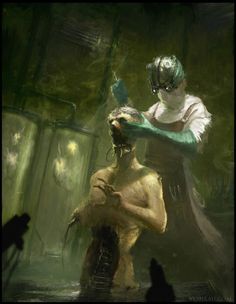
|
| Thomas Khan dead or alive? |
Once humans came into play, many of Thomas's staff became beyond uneasy. Humans were Class A citizens and under the highest protection of Imperial law. Thomas would insist they were tried criminals and outlaws, who didn't deserve to live, but most of the staff still felt the experiments too cruel and invasive to pass any Imperial regulations. Thomas was corned by his staff and detained. They shortly after contacted High Command and to their horror realized they had never been sanctioned to conduct the experiments in the first place. Infuriated and looking for answers the staff stormed to Thomas's holding cell only to find him gone. One by one, staff members disappeared and reappeared in various states, unidentifiable in some cases, as if a rabid beast had ripped them to shreds. In the end, Thomas had succeeded in capturing the remaining staff. He used the stations system and his unrestricted control against them, blocking them off and locking them down in remote parts of the complex.
What followed is tales of legend. Many say Thomas continued his unnatural experiments, enslaving his staff, forcing them to pursue his insatiable appetite for discovery. Other say that he experimented on his staff members, eventually went completely mad and fled the station. What we do know, is when Imperial Command sent a detachment to the station, Thomas was gone. Left behind was a sight those who were there described as something out of a horror book. Hardened veteran troopers returned shaken, unable to speak intelligently. The Throne ordered the station closed. An investigative team from ISB was sent to try and piece together what went wrong and how it could have slipped past them. The forged documents were never found. It was suspected that Thomas had burned them all after his staff turned against him. ISB put high restrictions on the access to the station and sealed it up. Only the Throne and those agents involved in the investigation know what evidence was uncovered.
Planets
Talravin I

|
| Talravin I |
Talravin I is a barren, poisonous rock with very little purpose in the galaxy. The world was initially surveyed thousands of years ago and hardly any attention has been paid to the planet since. Nearly the entire surface of the planet is covered in glaciers formed when the planetary ozone layer unexplainably thickened, drastically lowering the planetary temperature.
The ice that the glaciers are comprised of contains a chemical that is fatal to human and near-human species when inhaled in its gaseous form. As such, some of the historically less-scrupulous arms dealers have occasionally visited Talravin I to mine the ice for use in biological weapons.
Bio Gold
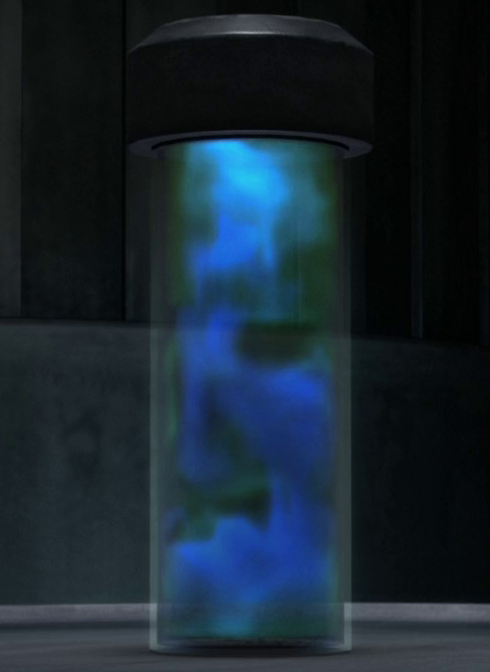
|
| A Biological Virus |
When Kel Dor spice smugglers first crashed on the planet of Talravin I in the early days of the Galactic Empire, they were met with an inhospitable landscape, full of hot fissures cracking through the ice shelves and temperatures that dropped dozens of degrees below freezing. However, due to their breath masks, they were able to survive the toxic gases that escaped the fissures under the ice, filling the atmosphere. Starving and with no way to make contact with anyone off-planet due to damaged communications to their ship, they were forced to endure, a hardship turned into a veritable goldmine. the Kel Dor were able to salvage their scanners. They were desperately looking for suitable shelter, lifeforms or food when the scanners went wild.
The gases escaping the cracks in the ice were showing a considerable amount of energy. This discovery peaked the interest of the smugglers due to their connections with arms dealers throughout the Outer Rim and Core Worlds. There were six Kel Dor when they crash landed on Talravin I, but by the time they found shelter, four of them had frozen to death on the icy tundra. For four days the last Kel Dor huddled together in a small hole they discovered in the side of one of the rocky glaciers, but the morning of the fifth day found one of the two dead.
It was only a miracle and the determined strength of the remaining Kel Dor that he was rescued, half frozen and starving on the ninth day after the crash. Both of his legs had to be amputated due to advanced frost bite and he died in his sleep only six months after leaving the planet, but not before he was able relay his discovery to his contacts in the Black Sun. The Outer Rim organization was able to send prospecting ships to the planets surface and extract valuable gases that were later used in biological weapon research by their R&D department. Due to the toxicity of the planet, the Empire paid little mind to the comings and goings of small ships in the system.
Talravin (II)

|
| Talravin |
Talravin is a small, frozen planet in the Talravin system.. Its atmosphere is listed as breathable, although that may be an overstatement. The atmosphere is very thin and the gases it contains are only breathable to a few sentient species, and would soon leave others suffocating. The planet has a strong magnetic field that interferes with most electronic equipment, and space travelers should be cautious in its vicinity.
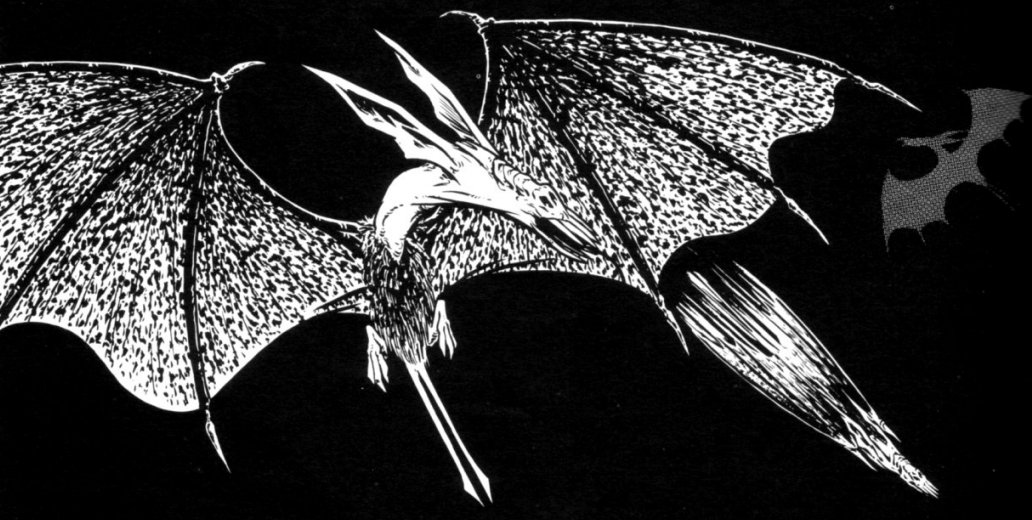
|
| Snow Shredder Bat |
Due to the strong magnetic fields keeping most ships and almost all colonizers away, the planet boasts a rather robust population of snow shredder bats that dot the inner cave systems of the planet. They feed off small tundra insects that live off the gas pockets found scattered across the snowy wastes and have, over time, developed small secondary wings that extend from their main wings to help them navigate and balance against the harsh winds that roll across the icy plains. Its the bat droppings within the cave systems that fertilize the rare bunches of white moss one may find. White moss was harvested and sold to extremely wealthy citizens who used them as part of floral bouquets at premiere wedding ceremonies. The lack of predatory creatures on the planet ensures that the bat populations will continue to thrive, producing the moss for generations to come.
Talravin III

|
| Talravin III |
Third planet from the Talravin sun, Talravin III is a type III gas giant. It's the largest planet in the Talravin System. Talravin III's extremely dense and relatively dry atmosphere is composed of a mixture of hydrogen, helium and much smaller amounts of methane and ammonia. The same mixture of elements which made Talravin also made the Sun in the system. It is reasonable to assume, that under more extreme conditions, Tal ravin III could have evolved into a double-star companion to the Sun. However, Talravin III would have had to become at least 80 times more massive to become a star.
The atmosphere is a few hundred miles in depth, pulled toward the surface by the intense gravity. Closer to the surface, the gases become more dense, and turn into a compound of slurry. The planet itself is composed almost entirely of liquid hydrogen and there is no real interface between the atmosphere and surface. Talravin III's rocky core lies well below the "surface" and is very hot (around 36,000 degrees F) due to gravitational compression.
As mentioned above, Talravin III's extremely fast rotation flattens the globe at the poles and drives extremely changeable weather patterns in the clouds which envelope the planet. The clouds are likely made of ammonia ice crystals, changing to ammonia droplets further down. It is estimated that the temperature of the cloud tops are about -280 degrees F. Overall, Talravin III's average temperature is -238 degrees F. Since Talravin III is only tilted slightly more then 3 degrees on its axis, seasonal fluctuations are minimal.
Talravin IV

|
| Talravin IV |
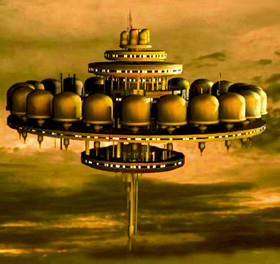
|
| Tibanna Gas Station |
Fourth planet from the Talravin sun, Talravin IV is a type III gas giant almost completely identical to it's neighboring planet Talravin III. The only difference between the two is that Talravin IV contains very small pockets of Tibanna Gas, which are mined by nearby stations. The output of Tibanna is very minimal. When the first peoples to mine the gas first surveyed the system, they didn't even consider it worth the cost of building stations.
As materials and building costs became cheaper, small stations that could be managed by limited personnel were constructed. A small team of five run each station and often those systems are nearly 100% automated, collections being made on a quarterly basis. Yet, even though the outputs are minimal, the rarity of the gas still brings it fair share of trouble. Luckily the nearby Golan II's keep most seeking to illegally syphon the gases away.